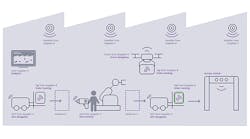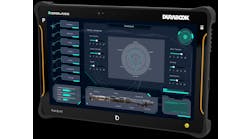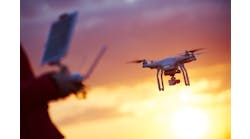Omlox standard unifies positioning, coordinates real-time location services
Where is the damned thing!?! It's an eternal cry—no doubt uttered during every human endeavor. It's relieved when each much-needed tool, part, workpiece or other crucial item is found, but what's often overlooked is all the time and effort wasted looking for them again and again.
Unfortunately, this struggle isn't much easier in today's increasingly digital age. Granted, data processing and storage advances make many tasks and searches easier. However, at the same time, the components and software they're made of—and the vast amounts of data and other content they produce—continue to multiply even faster than the capacity to search for them. Common methods and standards for networking, communications, edge and cloud computing and other digitalization technologies have streamlined some jobs and disciplines, but several areas haven't been addressed or are just getting started.
Location, location, location
One area that desperately needs standardization is the communication of position and other data by increasingly mobile technologies and their real-time locating systems (RTLS). Fortunately, they're getting an assist from the newly developed omlox open locating standard.
The goal of this uniform and interoperable positioning standard is to define open interfaces for interoperable localization systems, and enable interoperability and flexibility among trackable sources in one or multiple tracking zones. It provides the means to integrate existing location-related technologies, such as ultra-wideband (UWB), Bluetooth Low Energy (BLE), radio frequency identification (RFID), 5G wireless and global positioning systems (GPS). This lets omlox deliver geo-referenced positioning data via a uniform interface, and perform tracking. It can also handle dynamic spatial events like fencing, computing entries and exits, and cope with distances and potential collisions between trackable devices.
For instance, omlox enables users to pinpoint locations of forklifts, automated guided vehicles (AGV), drones or other mobile tools, and equipment from different manufacturers, which can all use the same infrastructure. It also allows position data to be used more widely across facilities. Users can even locate and track devices inside buildings with accuracy reportedly down to centimeter ranges, which is similar to what GPS can provide outdoors.
Need to know
"The key challenge is finding stuff in industrial automation and support processes, and using standardized locating and positioning to do it," says Matthias Joest, CEO at Heidelberg Mobil and committee leader for omlox at Profibus & Profinet International (PI). "This effort began in 2018, when several German companies, including Trumpf, Sick, Pepperl+Fuchs, Deutsche Telekom and a few smaller software firms sought to make locating systems less expensive and more accessible. They developed the initial standard and transferred it to PI in 2020, so it could be scaled up. It already has 80 actively engaged PI members worldwide, and all other PI organizations are welcome to join."
Michael Bowne, executive director at PI North America, adds that, "Previously, all locating and positioning technologies were proprietary, so they usually couldn't talk to each other. Now, omlox gives us an open standard that lets them communicate. The new standard also unifies indoor and outdoor locating and wireless protocols and technologies. This is important because Bluetooth, Wi-Fi and UWB work at short ranges, so they're not good outdoors, while GPS and similar technologies don't do as well indoors."
Bowne adds these traditional limitations on locating and positioning are what inspired omlox's initial designers to develop it. "They collected information and examples about what users needed from their processes, assets and digital twin counterparts, and it turned out that location data from AGVs, autonomous mobile robots (AMRs) and other equipment was extremely important," says Bowne. "It really is crucial to know where those 'damn things' are. We also expect to see more AMRs in industry, which will also help improve worker safety."
UWB and middleware
To gather real-time locating data from tools and equipment, and deliver it to upper-level consumers, omlox concentrates on two main areas. "The first is specific location technologies that aren't presently covered by any standardization initiative or body. There are many small vendors, who haven't been able to mix or match their technologies yet. Omlox is standardized on UWB hardware that provides ease-of-use similar to Wi-Fi," says Joest. "The second aspect of omlox is its locating middleware, which lets users bring in any mobile device, tags or other assets for which positions are needed, such as handheld devices or AGVs."
This middleware can receive data from RFID, GPS, UWB or other tags, according to Joest. It then translates and streamlines x-y-z coordinates or other data, which were previously in different proprietary formats, into a single, standardized format that can be part of a global reference system. "This is what lets users track where any device is by accessing different locating technologies," explains Joest. "Omlox has standard APIs for users, which communicate down to mobile tools and production and transportation equipment with RFID, Bluetooth, Wi-Fi, UWB, GPS and 5G, and communicates up to devices and software that need their data, such as manufacturing execution systems (MES), warehouse management, order fulfillment, enterprise resource planning (ERP) and supply chain applications."
Core zone, hub and APIs
Using its networking and software aspects, omlox provides two primary functional capabilities—omlox core zone infrastructure and omlox hub and its APIs—and defines their interfaces.
Omlox core zone works in conjunction with open interfaces and UWB radio standard technology, which is often used for indoor locating in facilities, such as navigating AGVs, AMRs or drones, as well as locating materials or orders. On one side, an omlox air-interface connects mobile devices like AMRs and infrastructure such as satellites. On the other side, omlox hub and its APIs connect the core zone with the hub.
Interoperability allows companies to easily network all omlox-enabled UWB products, regardless of manufacturer. The benefits of UWB include high accuracy and precision down to less than 10 cm; low sensitivity to interference at 4GHz; high data transmission rates; low power consumption; and guaranteed interoperability (Figure 1).
Beyond UWB, the omlox hub works with the other locating technologies typically used in production, delivery and storage, such as RFID, 5G, Bluetooth, Wi-Fi and GPS. Omlox hub enables interoperability and flexibility across these different, complementary zones. This also allows applications such as production control systems, goods tracking and navigation to be networked across zones.
The benefits of omlox hub include:
- Open and interoperable with no lock-in effect;
- Displays all elements in a smart factory map;
- Seamless indoor and outdoor tracking of assets across technology boundaries;
- Use of existing locating services in brownfield facilities and retrofitted settings;
- Reduced amortization costs by eliminating costly integration projects;
- Easy plug-and-play implementation; and
- Broad consortium with a wide range of products.
Play nice, avoid snags
Because omlox comes in contact with and bridges so many other protocols and technologies, Joest reports its developers wisely concentrated the standard on acquiring and relaying locating and positioning information from mobile devices, and leave it up to other support organizations to decide what to do with their data before and after it's transferred.
"Real-time locating includes many technical aspects, so omlox's developers talked with representatives of other networking standards, so they could align it with them," says Joest. "Omlox is very distinct in what it does. It's not doing the Industrial Internet of Things (IIoT), describing assets, or running machine-to-machine or machine-to-cloud applications. Omlox's goal is just to provide access to location data."
Omlox is already aligned with the other protocols administered by PI, including Profibus, Profinet and IO-Link. It can also serve in conjunction with the Standard Robot Command Interface, and is aligned with the new Module Type Package (MTP) standard. "PI's protocols are evolving from communications to a wider scope of digitalization capabilities," adds Bowne. "Omlox is a part of this, too."






